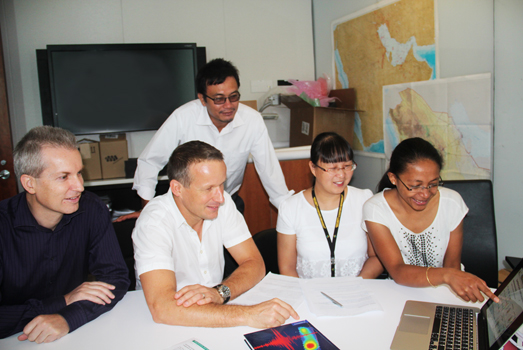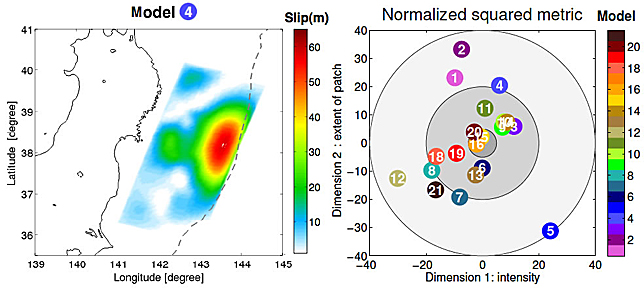Cross-disciplinary collaboration results in groundbreaking earthquake research

KAUST's cross-disciplinary collaboration between researchers from two Univeristy divisions produced advances in earthquake research. L-R: Prof. Marc Genton, Prof. P. Martin Mai, Dr. Kiran Thingbaijam, Dr. Ling Zhang and Ph.D. student Hoby Razafindrakoto. [Photo by Caitlin Clark]
For KAUST research assistant Dr. Ling Zhang and Ph.D. student Hoby Razafindrakoto, a class in statistics the two took together on campus was a serendipitous event.
"Hoby and Ling came to my spatial statistics class in the spring of 2013," explained Marc Genton, Professor of Statistics in the Computer, Electrical and Mathematical Science and Engineering Division. "They had to do a project for the class, and their project morphed into a collaboration that produced two papers and an online tool for uncertainty quantification in earthquake source modeling."
The group effort included P. Martin Mai, Professor of Earth Science and Engineering in the Physical Science and Engineering Division, and KAUST postdoctoral fellow Dr. Kiran Thingbaijam.
The researchers' work was published recently in Geophysical Journal International [DOIs: 10.1093/gji/ggu383; 10.1093/gji/ggv088], and their tool is accessible at equake-rc.info, a website hosted by SIV, the international collaboration on Source Inversion Validation for earthquake rupture imaging.
New Tool Developed
"We developed a ranking tool based on statistical techniques that is able to classify any 2D field scientists try to model. In geoscience, this could be temperature or precipitation, for example," said Hoby. "However, our case is unique because we apply the tool to compare 2D fields describing the earthquake source process."
Inferring an earthquake rupture model from seismic and geodetic data is challenging because the models exhibit "remarkable variability," Ling noted. These variations occur because of uncertainties in modeling assumptions, the use of different inversion algorithms, or differences in data selection and processing.

(Left) An example of a slip model for the 2011 Tohoku earthquake extending about 400 km in north-south and 200 km in east-west direction. Colors indicate the slip (displacement) on the rupture plane reaching up to 60 m close to the Japan trench (grey dashed line) that marks the subduction zone between the Pacific and Eurasian Plates. The black line depicts the coast line of Honshu, Japan. (Right) Multidimensional scaling configuration for 21 Tohoku slip models inferred by different teams and methods with respect to the mean model. Circles limit different levels of similarity (excellent - dark grey, good - grey, fair - light grey, and poor - outside the circles). [Image by Hoby Razafindrakoto, Martin Mai and Marc Genton.]
Comparing Earthquake Models
Because of these issues, "a robust statistical comparison of different rupture models obtained for a single earthquake was needed to quantify the inter-event variability," Kiran said.
The researchers examined the performance of the spatial prediction comparison test (SPCT) to compare spatial random fields and the multidimensional scaling (MDS) approach to quantitatively compare rupture models.
"We implemented and calibrated the SPCT approach for a suite of synthetic two-dimensional slip distributions, and found SPCT was a simple and effective tool for ranking slip models with respect to a reference model," Ling explained.
For the MDS approach, the researchers tested six different 2D random fields and formulated a similarity scale to rank the rupture models. They used models from the March 11, 2011 Tohoku, Japan earthquake that resulted in the devastating tsunami and Fukushima Daiichi Nuclear Power Plant disaster, and found the models and their predictions "cluster with a systematic deviation from other models," said Hoby.
"We were surprised by the power of the MDS and SPCT statistical tools," Hoby noted. "When we ran synthetic experiments, we found the tool could detect small-scale dissimilarities."
The researchers' findings show the ranking tools are important for the 2D field to quantitatively assess and rank different model predictions.
"Our results benefit the seismological community, as a consistent earthquake source process for a particular earthquake is critical for tsunami and ground motion simulation studies," Hoby said. She noted they could "eventually extend our work by analyzing both the spatial and temporal processes."
Successful KAUST Collaboration
"The complexity of problems in earthquake seismology requires sophisticated tools that demand collaborative efforts from many different fields," said Prof. Mai. "We are fortunate that collaboration like this is possible at KAUST. Our work is a great example of successful partnership between statisticians and earthquake seismologists."
Prof. Genton noted that the team's work "exemplifies what we would like to achieve in the classroom – the extension of teaching material to a full-blown research project that is published and made into a real-world application. This is also a wonderful opportunity for the students to step outside their comfort zone and learn more."
"The open structure of KAUST really facilitates this type of interaction," added Prof. Mai. "It is beautiful to realize that this small-scale project now has an influence on a much larger community where there is a lot of visibility. That is an amazing step for students who were inspired by a project in the classroom."
- By Caitlin Clark, KAUST News

